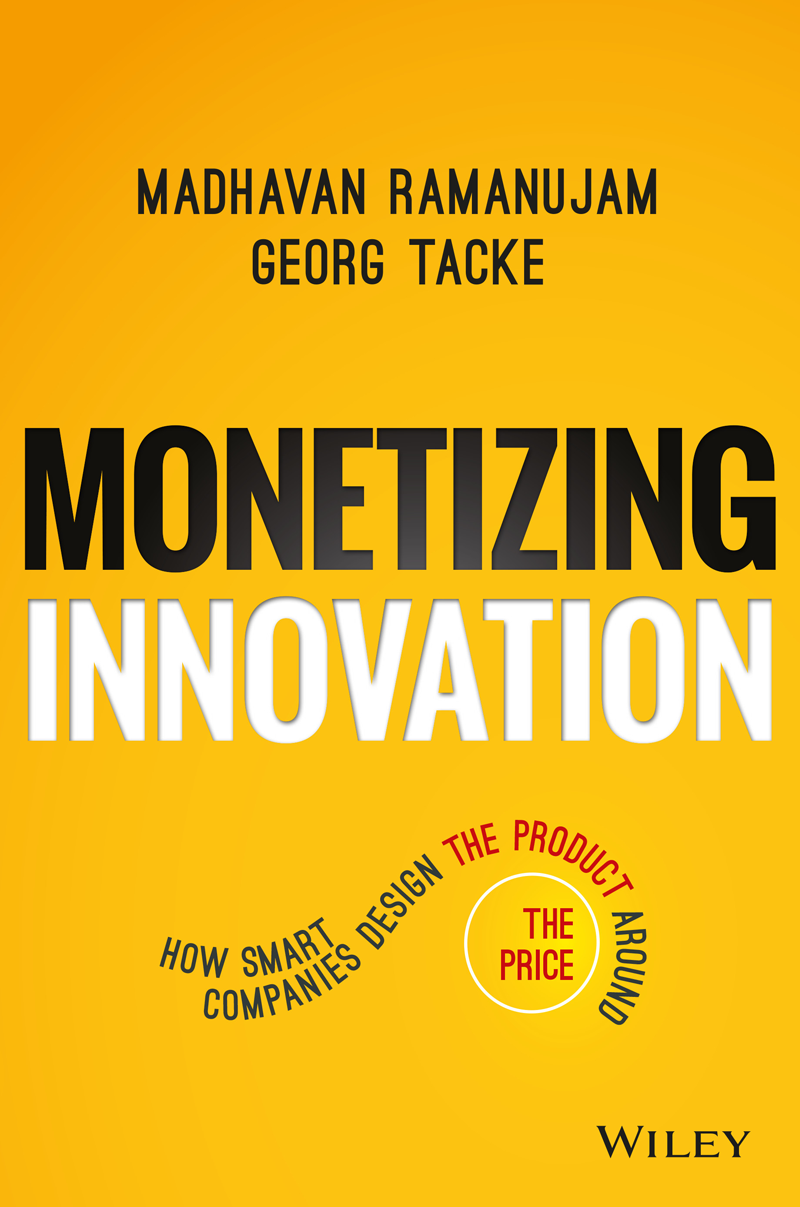I am at the Intrapreneurship Conference in Palo Alto today and “Monetizing Innovation” by Madhavan Ramanujam and George Tacke. The book is a fast read that incorporates a some pricing theory into new product introduction, here are nine rules they offer for a successful innovation.
Nine Rules from Monetizing Innovation
1. Have the “willingness to pay” talk with customers early in the product development process to ensure you’re building something customers will pay for. By doing it early you can prioritize features appropriately. The key is to determine what the customer values and is willing to pay for. Pricing is key to product market fit
2. Don’t force a one-size-fits-all solution. Build segments based on differences in your customers’ willingness to pay for a new product. This is also true for messaging: demos, presentations, and proposals.
3. Product configuration and bundling is more science than art. Here a jobs-to-be-done approach is much more useful than demographics for B2B offerings.
4. Choose the right pricing and revenue model. How you charge is often more important than how much you charge. Linking this to how the customer realizes value from the offering is essential. Especially if you absorb much of the adoption for new prospects so that they only pay for the value they experience.
5. Develop your pricing strategy. Look a few steps ahead to maximize gains in the short and long term. The realities for a startup is that early customers may require a discount or pricing model that reflects the considerable risks of your offering not delivering value. Managing the transition once you have strong
6. Draft your business case using customer willingness-to-pay data, and establish links between price, value, volume, and cost. The basis for your product price has to be the value it creates in your customer’s business.
7. Communicate the value of your offering clearly and compellingly; otherwise you will not get customers to pay full measure. Less is more, if the top two or three features or outcomes from using your product are not convincing the next six probably won’t help. You can tailor your message to the job that your customer needs your product to do for them: it’s a good idea to do some discovery or targeting before launching into your demo or presentation.
8. Understand your customers’ irrational sides, because whether you sell to other business or to consumers, your customers are people. In the book this is a pretext for introducing a lot of pricing theory that’s more applicable to consumer markets. I would substitute the need for understanding the culture and language of an industry so that you can pass the “shibboleth test.” Your conversations with prospects about issues and alternatives are in the language of the prospect.
9. Maintain your pricing integrity. Control discounting tightly. If demand for your new product is below expectations, only use price cuts as a last resort, after all other measures have been exhausted.
SKMurphy Perspective
Bottom line it’s a book worth reading. The First Round post “Madhavan Ramanujam–It’s Price Before Product. Period” captures about 80% of the value for startups so I would start there. There are better books on pricing: for a straight up analysis of product pricing The Strategy and Tactics of Pricing” by Thomas Nagle is the best book that I have read.
Many early sales for a new technology look much more like a consulting engagement (this is sometimes referred to as “concierge model” or “service first” where you use the technology to a achieve a result your customer pay for but buffer them from its failure and sharp edges. Here are three books on selling professional services that may prove more useful for this stage:
- Winning the Professional Service Sale by Michael McLaughlin
- Value Based Fees by Alan Weiss
- Secrets of Consulting by Gerald Weinberg
Related Blog Posts
- Q: Pricing Professional Services
- Tangible Costs and Pricing to Value”
- How to Pull the Trigger on a Pricing Model
- Mark Stiving: Three Pricing Principles I confirmed in Las Vegas
- Peter Cohan: Differentiating Your Offer Starts With the First Contact With the Customer
- Price, Value, and Your Prospect’s Perception of Risk
- Mapping the Path to Your First Dollar of Revenue
- First Round: “Madhavan Ramanujam–It’s Price Before Product. Period.


Pingback: December 2016 Event Roundup for Bootstrappers Breakfast Silicon Valley